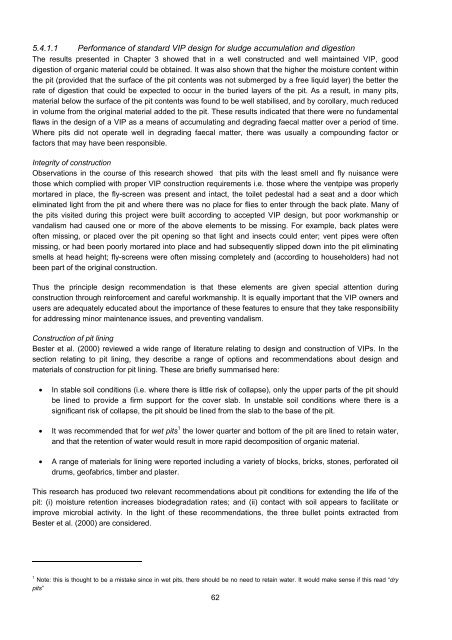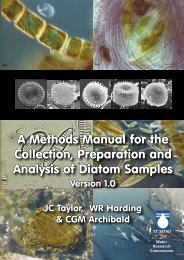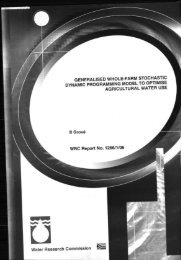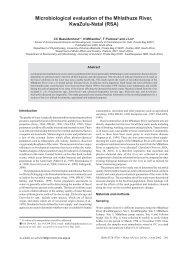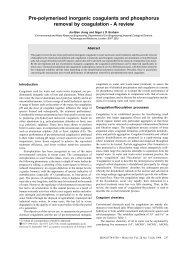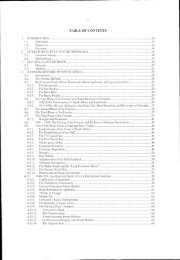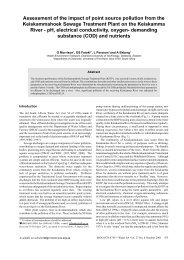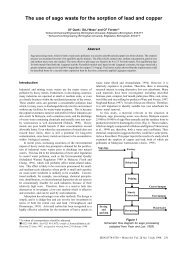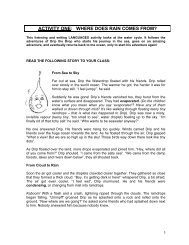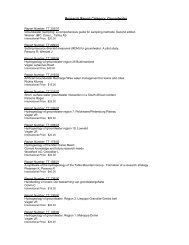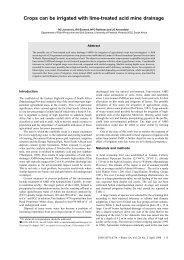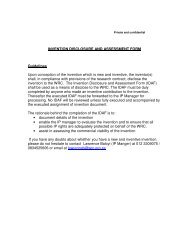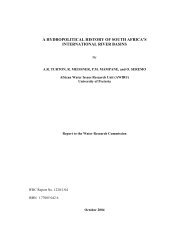and the Efficacy of Pit Latrine Additives - Water Research Commission
and the Efficacy of Pit Latrine Additives - Water Research Commission
and the Efficacy of Pit Latrine Additives - Water Research Commission
- No tags were found...
You also want an ePaper? Increase the reach of your titles
YUMPU automatically turns print PDFs into web optimized ePapers that Google loves.
5.4.1.1 Performance <strong>of</strong> st<strong>and</strong>ard VIP design for sludge accumulation <strong>and</strong> digestion<br />
The results presented in Chapter 3 showed that in a well constructed <strong>and</strong> well maintained VIP, good<br />
digestion <strong>of</strong> organic material could be obtained. It was also shown that <strong>the</strong> higher <strong>the</strong> moisture content within<br />
<strong>the</strong> pit (provided that <strong>the</strong> surface <strong>of</strong> <strong>the</strong> pit contents was not submerged by a free liquid layer) <strong>the</strong> better <strong>the</strong><br />
rate <strong>of</strong> digestion that could be expected to occur in <strong>the</strong> buried layers <strong>of</strong> <strong>the</strong> pit. As a result, in many pits,<br />
material below <strong>the</strong> surface <strong>of</strong> <strong>the</strong> pit contents was found to be well stabilised, <strong>and</strong> by corollary, much reduced<br />
in volume from <strong>the</strong> original material added to <strong>the</strong> pit. These results indicated that <strong>the</strong>re were no fundamental<br />
flaws in <strong>the</strong> design <strong>of</strong> a VIP as a means <strong>of</strong> accumulating <strong>and</strong> degrading faecal matter over a period <strong>of</strong> time.<br />
Where pits did not operate well in degrading faecal matter, <strong>the</strong>re was usually a compounding factor or<br />
factors that may have been responsible.<br />
Integrity <strong>of</strong> construction<br />
Observations in <strong>the</strong> course <strong>of</strong> this research showed that pits with <strong>the</strong> least smell <strong>and</strong> fly nuisance were<br />
those which complied with proper VIP construction requirements i.e. those where <strong>the</strong> ventpipe was properly<br />
mortared in place, <strong>the</strong> fly-screen was present <strong>and</strong> intact, <strong>the</strong> toilet pedestal had a seat <strong>and</strong> a door which<br />
eliminated light from <strong>the</strong> pit <strong>and</strong> where <strong>the</strong>re was no place for flies to enter through <strong>the</strong> back plate. Many <strong>of</strong><br />
<strong>the</strong> pits visited during this project were built according to accepted VIP design, but poor workmanship or<br />
v<strong>and</strong>alism had caused one or more <strong>of</strong> <strong>the</strong> above elements to be missing. For example, back plates were<br />
<strong>of</strong>ten missing, or placed over <strong>the</strong> pit opening so that light <strong>and</strong> insects could enter; vent pipes were <strong>of</strong>ten<br />
missing, or had been poorly mortared into place <strong>and</strong> had subsequently slipped down into <strong>the</strong> pit eliminating<br />
smells at head height; fly-screens were <strong>of</strong>ten missing completely <strong>and</strong> (according to householders) had not<br />
been part <strong>of</strong> <strong>the</strong> original construction.<br />
Thus <strong>the</strong> principle design recommendation is that <strong>the</strong>se elements are given special attention during<br />
construction through reinforcement <strong>and</strong> careful workmanship. It is equally important that <strong>the</strong> VIP owners <strong>and</strong><br />
users are adequately educated about <strong>the</strong> importance <strong>of</strong> <strong>the</strong>se features to ensure that <strong>the</strong>y take responsibility<br />
for addressing minor maintenance issues, <strong>and</strong> preventing v<strong>and</strong>alism.<br />
Construction <strong>of</strong> pit lining<br />
Bester et al. (2000) reviewed a wide range <strong>of</strong> literature relating to design <strong>and</strong> construction <strong>of</strong> VIPs. In <strong>the</strong><br />
section relating to pit lining, <strong>the</strong>y describe a range <strong>of</strong> options <strong>and</strong> recommendations about design <strong>and</strong><br />
materials <strong>of</strong> construction for pit lining. These are briefly summarised here:<br />
<br />
<br />
<br />
In stable soil conditions (i.e. where <strong>the</strong>re is little risk <strong>of</strong> collapse), only <strong>the</strong> upper parts <strong>of</strong> <strong>the</strong> pit should<br />
be lined to provide a firm support for <strong>the</strong> cover slab. In unstable soil conditions where <strong>the</strong>re is a<br />
significant risk <strong>of</strong> collapse, <strong>the</strong> pit should be lined from <strong>the</strong> slab to <strong>the</strong> base <strong>of</strong> <strong>the</strong> pit.<br />
It was recommended that for wet pits 1 <strong>the</strong> lower quarter <strong>and</strong> bottom <strong>of</strong> <strong>the</strong> pit are lined to retain water,<br />
<strong>and</strong> that <strong>the</strong> retention <strong>of</strong> water would result in more rapid decomposition <strong>of</strong> organic material.<br />
A range <strong>of</strong> materials for lining were reported including a variety <strong>of</strong> blocks, bricks, stones, perforated oil<br />
drums, ge<strong>of</strong>abrics, timber <strong>and</strong> plaster.<br />
This research has produced two relevant recommendations about pit conditions for extending <strong>the</strong> life <strong>of</strong> <strong>the</strong><br />
pit: (i) moisture retention increases biodegradation rates; <strong>and</strong> (ii) contact with soil appears to facilitate or<br />
improve microbial activity. In <strong>the</strong> light <strong>of</strong> <strong>the</strong>se recommendations, <strong>the</strong> three bullet points extracted from<br />
Bester et al. (2000) are considered.<br />
1<br />
Note: this is thought to be a mistake since in wet pits, <strong>the</strong>re should be no need to retain water. It would make sense if this read “dry<br />
pits”<br />
62


